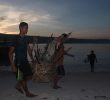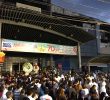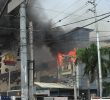100,000 people newly displaced by fighting during 2006
With more than 18,000 people displaced by intermittent clashes between MILF rebels and government forces in Midsayap, North Cotabato between January and March, 2007 appears to have started on the same basis as the previous year. During 2006, conflict-induced displacement was mainly the result of armed confrontations between government security forces and Muslim rebels in Mindanao or communist insurgents elsewhere in the country. It is estimated that close to 100,000 people were displaced during the year, mainly in the Muslim-populated areas of Mindanao. The two largest displacement incidents occurred in and around Mamasapano municipality, in Maguindanao province. In late January 2006, a week of fighting involving security and paramilitary forces against MILF rebels resulted in the evacuation of 32,000 civilians. In late June 2006, fighting between the Muslim rebels and the pro-government militias erupted again in Shariff Aguak town in the same province. This time the clashes displaced close to 40,000 people. As was the case six months earlier, the majority of the displaced managed to go home shortly after the fighting ended two weeks later.
Elsewhere in the country, thousands of people were displaced due to armed clashes between the government and the communist NPA. In October 2006, more than 5,000 people fled their homes in Calatrava, Negros Occidental province following counter-insurgency operations against NPA rebels (DSDW, 25 October 2006). Fighting and displacement also resumed in Sulu province, where the government deployed some 7,500 troops in August in the hunt for another small Muslim rebel organisation, the Abu Sayyaf group (ASG). At least 3,000 people were displaced on Jolo island between August and September 2006 by the military operations (DPA, 3 August 2006; eBalita, 15 September 2006). The ASG, allegedly linked to al-Qaeda, has since 2001 resisted several large-scale military operations conducted the Philippine government forces with support from the United States. These operations, carried out in the framework of the global �war on terror�, have been met with scepticism and cynicism by Moro civil society groups who see it as a justification for continued warfare on the Muslim population leading to further human rights violations and displacement (Mindanews, 6 August 2006; Davao Today, 9 September 2006). The adoption by the Congress, on 19 February 2007, of an anti-terror bill, known as the �Human Security Act� raised concern among Moro groups that it would further curtail civil and political rights in Mindanao (Davao Today, 11 February 2007).
Sporadic clashes, constant movement of people and poor monitoring of returns make it very difficult to estimate how many people remained displaced at the end of the 2006. While the majority of the displaced generally manage to return to their homes in the aftermath of the fighting, many are unable to do so mainly because of the destruction of their houses, means of livelihood or because of continued military presence in or around their villages. This is a common feature of displacement in the conflict-affected areas of Mindanao with new waves of displacement just adding new layers of displaced persons to those created by previous clashes. Returns during a year are generally offset by new displacements, creating a permanent IDP caseload consisting of tens of thousands of people living in evacuation centres or with relatives. In addition, many people who have managed to return in past years have not been able to recover economically or socially from their displacement and remain living in situations akin to displacement with acute assistance and rehabilitation needs. The UN World Food Programme estimated in 2006 that there were 120,000 vulnerable IDPs in need of food assistance in Mindanao (WFP, March 2006, p.3).










